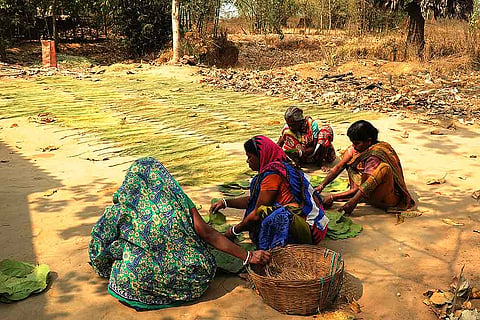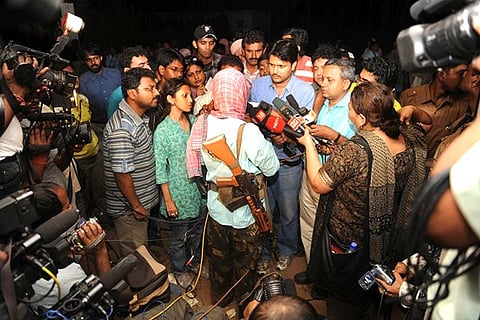The year was 2009. A farmer from a village called Tiyakati in West Bengal’s western, forested Jhargram district, was returning from his paddy field when one of his neighbours rushed out of his mud hut and shouted, “They are calling us for a meeting. Get there quickly.” When the farmer reached the spot, an open field by the jungle, he saw nearly 200 other villagers—men, women and children. They were all told to gather at the nearest railway station, Banstala. When the Delhi-bound Rajdhani Express was to pass through, they were to bring it to a halt by throwing stones at it. They did as they were told.
A New Road To Kishenji’s Fortress
The Maoists once held sway over Jangalmahal. After their defeat, the state seems to care more for the poor.
“We were called out any time of the day and night to do their bidding,” the wife of the farmer—call her Kamala—tells Outlook. “If we refused, we would be punished. Their demands were many. We were expected to cook for them whenever they arrived. The poor would get away by serving just rice and greens or maybe some daal. The rich ones would have to cook eggs, fish or chicken. They came usually unannounced and in large groups. And mostly in the dead of night. But the demand that was feared the most was when they asked us to sacrifice a family member so that they could take him or her with them.” The Maoists—on the ascendant for several years in this area right in the middle of ‘Jangalmahal’, an area made of bits of Bankura, Birbhum, Midnapore districts and tracts of the Chhotonagpur plateau in Jharkhand—squeezed them dry when there was little to extract.
Kamala doesn’t know whether her husband joined the rebels or not, but he has been missing these eight years. “I don’t even know if he is alive,” she says, her lifeless eyes fixed in the far distance. A hard existence has hardened emotions too. “Sometimes after I finish my household chores, I walk to the railway station and stare at the forest beyond, thinking, ‘is that him?’.”

Making plates out of Sal leaves
Locals still call it, as they have always done, the “dreaded Malaboti Jungle”. This “enchanted forest of garlands”, as its name means, is a vast expanse, studded with magnificent stands of towering saal trees that just about let the sun’s rays stream through in ethereal shards. Stretching from Jhargram (which till March 2017 was in West Midnapore district) to the bordering state of Jharkhand, it was, say villagers, once the haunt of demons. “Earlier, ‘rakshases’ roamed these areas,” says Kamala, naively trusting of the old wives’ tales. “The Rakshasas cursed the land and declared that evil would befall any human who invaded their space. We never did. But ‘they’ didn’t believe in such things.... Look what happened to them.”
For, the Maoists—members of the banned Communist Party of India (Maoists), who operated through Jangalmahal ever since the mid-1990s—are as extinct as the demons who put a hex on trespassers. Beginning in 2009, they were flushed out in a series of police and paramilitary operations. It was here that Koteshwar Rao or Kishenji, the chief of the Maoists’ Bengal operations, was shot dead in November 2011 in an encounter with Commando Battalion for Resolute Action (CoBRA) and CRPF forces. These forests were the entry point of the militant leader into Bengal from Andhra Pradesh via Jharkhand. Aiming to trigger Maoist operations in the state, Malaboti’s thick vegetation offered perfect cover to the rebels, who poured in and out of the connected series of jungles in the vicinity with practised fluidity. In Malaboti, they set up their earliest training camps in this region; it was their launchpad into Jangalmahal.
That the Maoists had expanded their operations into the jungles of West Midnapore would perhaps not have come to light until the then Left Front state government decided to turn towards it for industrial expansion. Or, more accurately, if the Maoists hadn’t tried to thwart the government’s plans of industrialisation. Then chief minister Buddhadeb Bhattacharjee had inaugurated a steel plant of the Jindal Group in Salboni in November 2008. On his way back to Calcutta, a bomb blast narrowly missed his convoy. Exposed wires of the crude IED that the police dug out of the road was traced to a nearby village. Maoists claimed responsibility, or ‘credit’. It betrayed confidence bordering on audacity; the state government was fair game.
“They felt that Jangalmahal was their turf,” an official of the then district administration in Jhargram, who was in charge of distribution of rural schemes in tribal villages from 1999 to 2011, tells Outlook. “We who worked there knew that the Maoists were there. They had been gathering, recruiting, training and expanding.” He claims that the Maoists were running a parallel government. “They had executive and legislative bodies and even a judiciary, which tried people in kangaroo courts.” The peasants who were dragged into their fold—villagers Outlook spoke to said Maoists dragooned at least one member from each family—were paid by them for work done.
The former administrative official denies allegations that government funds were never properly distributed to Jangalmahal villagers, leaving them impoverished and with no option but to turn to the Maoists. “Maoists made it impossible for us to do any work in the jungle villages. We government officials were their prime targets,” he says.

Kishenji with the media in 2009
Not all agree. And that includes the people. “What did we eat before?” Hangsha Murmu of Belpahari asks, breaking into a toothy, unnerving laughter. “I ate what my lazy wife gave me,” he jokes, pointing at the old, emaciated woman by his side. “Mostly, she gathered green leafs from the forests and told me to wash it down with water,” he chortles. “What kind of man are you that I have to feed you?” asks his wife in mock anger. “You never did any work!” As if accepting that charge, he says he has no profession, but can be described as a ‘forest dweller’. He remembers when the first Maoists started trickling in. “We started seeing these men carrying guns. Then they went from house to house, telling us they will give us a better life. That our land and resources were being drained by the government and that they were stealing our food.”
Officials who dealt with Maoist insurgency don’t deny that Maoist-affected areas were in a state that made them distinctly vulnerable to such ideology. “There was definitely a problem of poverty in the remote jungle regions which Maoists infiltrated,” says B.D. Sharma, former BSF special director-general and former director-general of Sashastra Seema Bal. “I dealt with Maoist Insurgency in the most affected parts of Bihar, Chhattisgarh and Orissa too, and in my experience, these were some of the most backward and deprived regions in the country.”
Currently advisor to the West Bengal government, he says, “This is why Chief Minister Mamata Banerjee has taken a two-pronged direction to solve the Maoist problem in Jangalmahal. It is being called the West Bengal Model and is being followed in other parts of India. She has simultaneously crushed the insurgency by using force and undertaken mass development through public distribution schemes for the benefit of locals. One of the key areas is employment, such as 100-days work and other income generating activities. Giving ration at highly subsidised prices to BPL families is another successful scheme. The strategy is akin to ridding the body of a disease with a strong doze of antibiotic, then following a healthy diet to keep illnesses from creeping back in.”
Indeed, so focused is the Trinamool government on keeping Jangalmahal free from Maoists, it has made Jhargram a separate police district for closer scrutiny. The CM has also made it a point to visit Jhargram at least once a month.
Outlook’s travels through Jangalmahal indicate that Bengal’s strategy seems to have been effective. If, through the decade between 1999 and 2009 Jangalmahal had harboured a dark secret, that of bearing militants who, using grinding penury as a tool, kept people on a tight leash through fear and intimidation, the decade since has been a revelation—political will can usher in change.
After the worse of the threats had been seen off, the state government had allowed a period of surrender to Maoists, who were promised absorption into the mainstream if they gave up arms. The wife of a former Maoist in Jhargram explains the process of a wily co-option: “The real idealogues didn’t surrender because they are truly Maoist. They went to jail. But most villagers who were forcibly inducted and given arms training have been absorbed into the police force; they have all turned informers as they know all the hideouts and the secret jungle routes. Maoists are no longer safe here.” She says that the only ‘sympathisers’ remaining are those who have not got jobs in the police or government; even they don’t care about Maoism, but are merely a gaggle of malcontents. “So, they have kept the opportunity open of swinging in whichever direction they will get some benefit from,” she adds.
At that height of the Maoist menace, there was an exodus of youth away from these parts, who dreaded the extremist press gang. In sharp contrast to the Naxal movement in Bengal, especially in Calcutta, which attracted the intellectual urban youth in the late ’60s, locals say the prospect of falling prey to Maoist recruiters mortified the boys and girls of Jangalmahal.
Nine years ago—as joint forces combed the forests and hunted out the rebels—when Outlook visited Jangalmahal, people rarely took sides. Scared and suspicious, they spoke in whispers, if at all. “Earlier, if we talked against them (most people will still not utter the ‘M’ word) or didn’t do what they told us to do, they would come at night and take us away, beat us up or kill us. If we sided with them, the police would come during the day and pick us up, beat us up and probably put us behind bars for life,” says Lamba Majhi, a goat herder in Banstala village. The issue is a common one seen in all Maoist-hit areas—poor villagers caught between ruthless rebels and an equally pitiless, punitive state. Villagers say that 20-year-old Majhi was beaten mercilessly by both the police and the militants. “See how stooped he is; that’s because they broke his back,” says a neighbour. Another one cuts in, “That’s because he is so stupid. He should have been agreeing with the police when they picked him up and agreeing with the Maoists when they did.” The villagers break into a loud cackle, including the boy with the broken back. Their laughter has been bought dearly.
“We have broken the back of militancy,” thundered Mamata Banerjee at a rally in Jhargram this month. She announced more populist schemes over and above the bicycles for girls and the Rs 25,000 they would get if they complete their school education, as per the Kanyashree scheme. Housing, training in special skills, recruitments in administrative jobs. The dark clouds that passed over Malaboti jungle, wreathing that enchanted forest in spectral shadows, seem to finally have revealed their silver lining.
By Dola Mitra in Jhargram